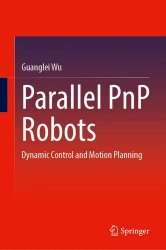 Название
Название: Parallel PnP Robots: Dynamic Control and Motion Planning
Автор: Guanglei Wu
Издательство: Springer
Год: 2025
Страниц: 292
Язык: английский
Формат: pdf (true)
Размер: 28.0 MB
This book provides the design and application of multiple control algorithms and motion planning to a family of parallel robots, which can be generalized to other robot counterparts. The book covers the fundamentals of dynamic models for control design, as well as a comparison of the control effects from the classical to advanced control algorithms step by step, which can help the researcher to understand the design procedure of control algorithms. It also includes different trajectory planning algorithms to ensure optimal robot performances. Furthermore, the research results previously scattered in many prestigious journals and conferences worldwide are methodically edited and presented in a unified form. The book is likely to be of interest to university researchers, R&D engineers, and graduate students in industrial parallel robotics who wish to learn the core principles, methods, algorithms, and applications.
Aiming at enhanced control effect of fast-movement parallel robots, fuzzy control is designed and integrated into the PD-based torque control. This chapter firstly introduces the fundamental concept and design procedures of fuzzy algorithm, based upon which a fuzzy control law is designed in detail and integrated with the torque feedforward control. Two simulation scenarios, which are based on rigid dynamics and flexible-rigid dynamics of the parallel SCARA robot, respectively, are taken as example to illustrate and evaluate designed control laws. The simulation results of two cases verify the advantages of fuzzy controller compared to the original torque feedforward control.
In order to improve the controller robustness of the parallel SCARA robot, this chapter presents fuzzy based sliding mode control. The first step is the design of first-order sliding mode control, in which both of the simulation and experimental results turns out that the controller can effectively suppress the problem of joint buffetings, handling the un-modeled errors in the dynamic model of the robotic system. Aiming to reduce the influence of dynamic uncertainties and discontinuity of the switching function onto control stability and to enhance the suppression of the joint buffetings, two-order (i.e., super-twist) sliding mode control is adopted and integrated with fuzzy algorithm, of which the performance improvement of dynamic control can be realized.
Collect prestigious methods and results for dynamic control of parallel robots
Provide the design from fundamental to advanced control and trajectory planning algorithms
Present the core principles, methods, algorithms, and applications
Скачать Parallel PnP Robots: Dynamic Control and Motion Planning
[related-news]
[/related-news]